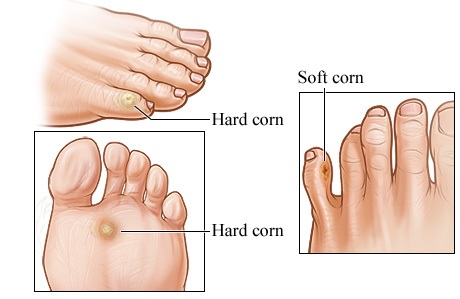Foot corns are one of those conditions that everybody has to deal with sooner or later, but nobody seems to understand it. Most of us have corns on our feet, but few of us know what they really are. Then what is a corn? A corn is actually your skin’s method of protecting itself from pressure and friction. Pressure and friction is generated when you walk, run, stand or engage in activities like bicycling or driving. The good news is that a corn on your foot will usually disappear on its own if you eliminate the source of the stress or friction.

What Is a Corn?
A cornor clavus is actually a specially-shaped piece of dead skin. It usually forms when the skin tries to protect the area underneath from rubbing, injury or blister caused by pressure. Corns are usually not painful unless they grow too large. Corns are most likely to be found on the hairless areas between the toes and the soles of the feet. They often affect people with foot problems because of uneven pressure on the feet.
Some of the signs of a corn include a hardened, raised bump, flaky or dry skin, thick or rough areas on the skin, and tenderness or pain under the skin. Many people that suffer from corns report that they feel as if they are "walking on stones". And with a corn on feet you are unable to walk long distances.
Difference Between Corn and Callus
Contrary to popular belief, corns and calluses are not the same thing. Some of the differences between the two include:
- Corns are usually painful when pressed, while calluses are almost never painful.
- Corns usually develop on the parts of your feet that do not bear weight, such as the toes. Calluses develop on the parts of your feet that bear weight, such as the soles.
What Causes Corns?
Now that we have known "what is a corn?" It's time to find out what causes corns. The main causes of corns and calluses are the way a person walks and the kind of shoes and socks he wears. Fortunately, corns often go away when some of these factors are changed. Some causes of corns include:
- Poorly fitting or tight shoes
- Poorly fitting socks
- Manual labor or excessive amounts of exercise, such as running or walking a lot
- Participation in athletic events, such as races, on a regular basis
- Going barefoot, particularly on concrete or gravel
- Hammertoes
- Bunions
- Deformities of the feet
- Injuries to the feet
- Scars on the feet
- Warts on the feet
Some people, such as manual laborers, those who walk a lot, and women who wear high-heeled shoes, are more likely to develop corns on their feet. People with a history of foot problems are also more susceptible to corns.
How Are Corns Treated?
Corns can make walking miserable and keep you from wearing beautiful sandals. "What is a corn" and "what causes corn" have been solved, our current task is to find the treatments. Here we provide ways to prevent corns, treat existing corns and prevent them from coming back.
1. Stop Corns from Happening
The best way to deal with corns is to prevent them from happening in the first place. Take the following steps to prevent corns:
- Change your socks every day and wash them in hot water.
- Use a pumice stone to remove dead skin on a regular basis.
- Wash your feet with warm, soapy water and a scrubbing brush every day.
- Use a foot cream to hydrate your feet.
- If you try on shoes or buy shoes, do it late in the afternoon or in the early evening because feet swell during the day so shoes bought in the morning may not fit by the time you get home at night.
- Antibiotics and antibiotic creams or ointments can help prevent infection. They can also kill warts, which can cause corns.
- Use special silicone foam wedges to prevent friction and pressure between toes.
2. Soak and Wipe Away the Corns
Simply soak your feet in warm or comfortably hot water. Then use a pumice stone or a skin file to sand the corn off once it is soft; be careful, and stop if you see blood. It is a good idea to add a disinfectant like tea tree oil to the water to prevent infections.
3. Use OTC Cream
Some over the counter medications and pads can help you get rid of corns. Be careful because some of the products use acid to burn away dead skin. Always read the labels when purchasing cream or consult your doctor.
4. Seek Professional Help
If the corn does not go away, you can go to a podiatrist or foot doctor. The podiatrist can tell you what you need to do to move the corn. The podiatrist can also tell you what causes the corn and how to prevent it from returning. Most health insurance plans will pay for podiatry if the doctor is in your network.
5. Prevent Corn Recurrence
The smartest thing you can do is take action to prevent corns from returning. Such actions include:
- Wearing shoes that are the right size for your feet.
- Using footpads to protect your feet. Custom-sized pads are available at many stores.
- Wearing orthopedic shoes or shoes designed for walking as much as possible.
- Wearing thick socks that absorb the pressure on your feet.
- Wearing tube socks because they don’t have seams, which can create problems.
- Wearing walking shoes such as sneakers whenever you have to walk for a distance.
If you want to know more ways of treating corns and calluses to get healthier feet, check out the video below: